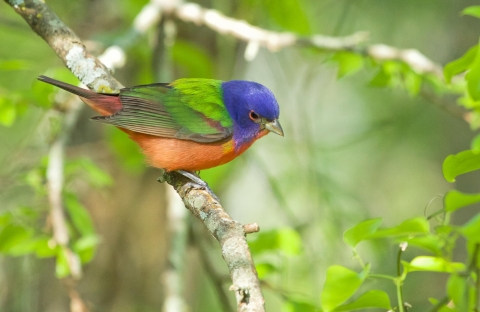About Us
Tishomingo National Wildlife Refuge is one of more than 560 national wildlife refuges that form a network of United States lands and waters managed specifically for wildlife. Refuges provide habitat–food, water, cover, and space—for millions of migratory birds, including over 380 threatened or endangered species and thousands of species of native plants and animals. The refuge and century-old town get their name from the famous Chickasaw Chief, Tishomingo. The refuge was established in 1946 as an administrative overlay of Corps of Engineers land on a portion of the Washita Arm of Lake Texoma. The primary purpose of the refuge is to protect and manage 16,464 acres of habitat as refuge and breeding grounds for migratory birds and other wildlife. The refuge also provides wildlife-dependent recreational activities including wildlife observation and photography, fishing, hunting, environmental education, and interpretive programs for the public. Habitats within the Tishomingo National Wildlife Refuge include 2,050 acres of wetlands, 10,000 acres of uplands, and 250 acres of croplands. These lands and waters are actively managed to support more than 284 species of birds, 41 species of mammals, 66 species of amphibians and reptiles, 67 species of butterflies and 54 species of fish.
The refuge has many superb places to experience birds. The headquarters boat ramp, the Prairie Pathways Trail, the Murray 23 boat dock and Jemison Overlook are good spots to see open water birds such as ducks, geese, and pelicans on the Cumberland Pool. You can find many species of sparrows as well as scissortail flycatchers, orioles, meadowlarks and many others from the Eagle Cove overlook “tower” just east of the Sandy Creek Bridge. The Craven Nature Trail is a great place to find woodpeckers, black and white warblers and blue-gray gnatcatchers in the forest section and grebes, ducks, herons and egrets from the boardwalk over Dick’s Pond. These are just a few of the wonderful sites available to view birds and other wildlife. Come early and often to experience the spectacular variety and abundance of birdlife on the refuge.
Our Mission
The mission of the National Wildlife Refuge System is to administer a national network of lands and waters for the conservation, management and, where appropriate, restoration of the fish, wildlife and plant resources and their habitats within the United States for the benefit of present and future generations of Americans.
Our Purpose
Every national wildlife refuge national wildlife refuge
A national wildlife refuge is typically a contiguous area of land and water managed by the U.S. Fish and Wildlife Service for the conservation and, where appropriate, restoration of fish, wildlife and plant resources and their habitats for the benefit of present and future generations of Americans.
Learn more about national wildlife refuge was created for a special purpose. Some were created to protect migratory birds, others to protect threatened or endangered species or unique habitats, while others fulfill another special purpose. Refuges are special places where wildlife comes first. All activities allowed on refuges must be evaluated to make sure each activity will not conflict with the reason the refuge was founded.
Our purpose is to serve as a refuge, breeding ground, and over-wintering ground for migratory birds and other wildlife.
Our History
1851 – The Chickasaw manual labor academy was open on present-day refuge lands. Funded almost entirely by the Chickasaw Legislature, it was the first boarding school for tribal youth in the Chickasaw Nation. In 1885 the academy was moved to a new location north of Tishomingo, Oklahoma.
1920 – Washita (Chapman) farm was created.
1939 – Denison Dam was constructed. It is a rolled earthfill embankment that formed Lake Texoma.
January 24, 1946 – The refuge was established by President Harry S. Truman to provide refuge and breeding grounds for migratory birds and other wildlife.
2015 – A historic flood event affected approximately 80% of the refuge. Some normally dry areas were underwater for 3 months and all buildings were flooded except one.
Other Facilities in this Complex
Tishomingo National Wildlife Refuge is an overlay on the U.S. Army Corps of Engineer’s Denison Dam and Lake Texoma project. The Wildlife Management unit (WMU) encompasses 3,170-acres and is co-managed by the U.S. Fish and Wildlife Service and Oklahoma Department of Wildlife (ODWCD).




